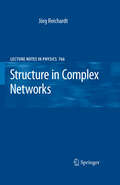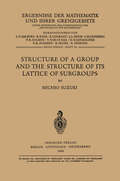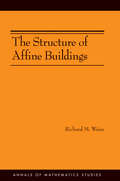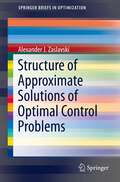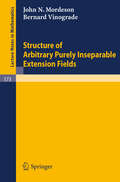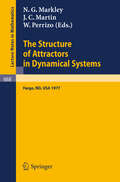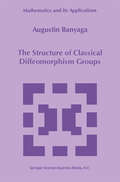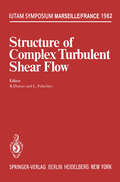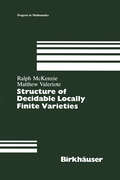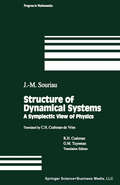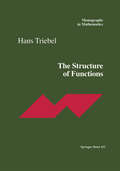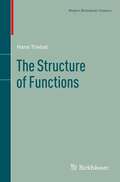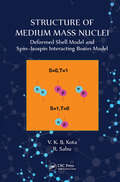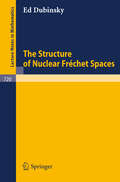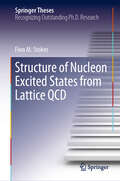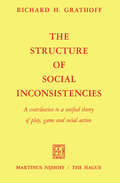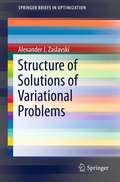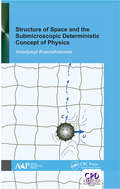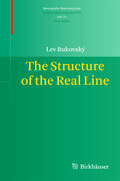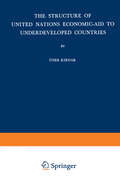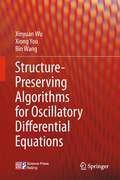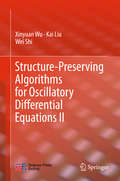- Table View
- List View
Structure in Complex Networks (Lecture Notes in Physics #766)
by Jörg ReichardtIn the modern world of gigantic datasets, which scientists and practioners of all fields of learning are confronted with, the availability of robust, scalable and easy-to-use methods for pattern recognition and data mining are of paramount importance, so as to be able to cope with the avalanche of data in a meaningful way. This concise and pedagogical research monograph introduces the reader to two specific aspects - clustering techniques and dimensionality reduction - in the context of complex network analysis. The first chapter provides a short introduction into relevant graph theoretical notation; chapter 2 then reviews and compares a number of cluster definitions from different fields of science. In the subsequent chapters, a first-principles approach to graph clustering in complex networks is developed using methods from statistical physics and the reader will learn, that even today, this field significantly contributes to the understanding and resolution of the related statistical inference issues. Finally, an application chapter examines real-world networks from the economic realm to show how the network clustering process can be used to deal with large, sparse datasets where conventional analyses fail.
Structure of a Group and the Structure of its Lattice of Subgroups (Ergebnisse der Mathematik und ihrer Grenzgebiete. 2. Folge #10)
by Michio SuzukiThe central theme of this monograph is the relation between the structure of a group and the structure of its lattice of subgroups. Since the first papers on this topic have appeared, notably those of BAER and ORE, a large body of literature has grown up around this theory, and it is our aim to give a picture of the present state of this theory. To obtain a systematic treatment of the subject quite a few unpublished results of the author had to be included. On the other hand, it is natural that we could not reproduce every detail and had to treat some parts some wh at sketchily. We have tried to make this report as self-contained as possible. Accordingly we have given some proofs in considerable detail, though of course it is in the nature of such areport that many proofs have to be omitted or can only be given in outline. Similarly references to the concepts and theorems used are almost exclusively references to standard works like BIRKHOFF [lJ and ZASSENHAUS [lJ. The author would like to express his sincere gratitude to Professors REINHOLD BAER and DONALD G. HIGMAN for their kindness in giving hirn many valuable suggestions. His thanks are also due to Dr. NOBORU ITo who, during stimulating conversations, contributed many useful ideas. Urbana, May, 1956. M. Suzuki. Contents.
The Structure of Affine Buildings. (AM-168)
by Richard M. WeissIn The Structure of Affine Buildings, Richard Weiss gives a detailed presentation of the complete proof of the classification of Bruhat-Tits buildings first completed by Jacques Tits in 1986. The book includes numerous results about automorphisms, completions, and residues of these buildings. It also includes tables correlating the results in the locally finite case with the results of Tits's classification of absolutely simple algebraic groups defined over a local field. A companion to Weiss's The Structure of Spherical Buildings, The Structure of Affine Buildings is organized around the classification of spherical buildings and their root data as it is carried out in Tits and Weiss's Moufang Polygons.
Structure of Approximate Solutions of Optimal Control Problems (SpringerBriefs in Optimization)
by Alexander J. ZaslavskiThis title examines the structure of approximate solutions of optimal control problems considered on subintervals of a real line. Specifically at the properties of approximate solutions which are independent of the length of the interval. The results illustrated in this book look into the so-called turnpike property of optimal control problems. The author generalizes the results of the turnpike property by considering a class of optimal control problems which is identified with the corresponding complete metric space of objective functions. This establishes the turnpike property for any element in a set that is in a countable intersection which is open everywhere dense sets in the space of integrands; meaning that the turnpike property holds for most optimal control problems. Mathematicians working in optimal control and the calculus of variations and graduate students will find this book useful and valuable due to its presentation of solutions to a number of difficult problems in optimal control and presentation of new approaches, techniques and methods.
Structure of Arbitrary Purely Inseparable Extensions (Lecture Notes in Mathematics #173)
by J. N. Mordeson B. VinogradeThe Structure of Attractors in Dynamical Systems: Proceedings, North Dakota State University, June 20-24, 1977 (Lecture Notes in Mathematics #668)
by N. G. Markley J. C. Martin W. PerrizoThe Structure of Classical Diffeomorphism Groups (Mathematics and Its Applications #400)
by Augustin BanyagaIn the 60's, the work of Anderson, Chernavski, Kirby and Edwards showed that the group of homeomorphisms of a smooth manifold which are isotopic to the identity is a simple group. This led Smale to conjecture that the group Diff'" (M)o of cr diffeomorphisms, r ~ 1, of a smooth manifold M, with compact supports, and isotopic to the identity through compactly supported isotopies, is a simple group as well. In this monograph, we give a fairly detailed proof that DifF(M)o is a simple group. This theorem was proved by Herman in the case M is the torus rn in 1971, as a consequence of the Nash-Moser-Sergeraert implicit function theorem. Thurston showed in 1974 how Herman's result on rn implies the general theorem for any smooth manifold M. The key idea was to vision an isotopy in Diff'"(M) as a foliation on M x [0, 1]. In fact he discovered a deep connection between the local homology of the group of diffeomorphisms and the homology of the Haefliger classifying space for foliations. Thurston's paper [180] contains just a brief sketch of the proof. The details have been worked out by Mather [120], [124], [125], and the author [12]. This circle of ideas that we call the "Thurston tricks" is discussed in chapter 2. It explains how in certain groups of diffeomorphisms, perfectness leads to simplicity. In connection with these ideas, we discuss Epstein's theory [52], which we apply to contact diffeomorphisms in chapter 6.
Structure of Complex Turbulent Shear Flow: Symposium, Marseille, France August 31 – September 3, 1982 (IUTAM Symposia)
by R. Dumas L. FulachierThe Symposium on structure of Complex turbulent shear flows was proposed by the "Comite National Fran
Structure of Decidable Locally Finite Varieties (Progress in Mathematics #79)
by Ralph McKenzie Matthew ValerioteA mathematically precise definition of the intuitive notion of "algorithm" was implicit in Kurt Godel's [1931] paper on formally undecidable propo sitions of arithmetic. During the 1930s, in the work of such mathemati cians as Alonzo Church, Stephen Kleene, Barkley Rosser and Alfred Tarski, Godel's idea evolved into the concept of a recursive function. Church pro posed the thesis, generally accepted today, that an effective algorithm is the same thing as a procedure whose output is a recursive function of the input (suitably coded as an integer). With these concepts, it became possible to prove that many familiar theories are undecidable (or non-recursive)-i. e. , that there does not exist an effective algorithm (recursive function) which would allow one to determine which sentences belong to the theory. It was clear from the beginning that any theory with a rich enough mathematical content must be undecidable. On the other hand, some theories with a substantial content are decidable. Examples of such decidabLe theories are the theory of Boolean algebras (Tarski [1949]), the theory of Abelian groups (Szmiele~ [1955]), and the theories of elementary arithmetic and geometry (Tarski [1951]' but Tarski discovered these results around 1930). The de termination of precise lines of division between the classes of decidable and undecidable theories became an important goal of research in this area. algebra we mean simply any structure (A, h(i E I)} consisting of By an a nonvoid set A and a system of finitary operations Ii over A.
Structure of Dynamical Systems: A Symplectic View of Physics (Progress in Mathematics #149)
by J.M. SouriauThe aim of the book is to treat all three basic theories of physics, namely, classical mechanics, statistical mechanics, and quantum mechanics from the same perspective, that of symplectic geometry, thus showing the unifying power of the symplectic geometric approach. Reading this book will give the reader a deep understanding of the interrelationships between the three basic theories of physics. This book is addressed to graduate students and researchers in mathematics and physics who are interested in mathematical and theoretical physics, symplectic geometry, mechanics, and (geometric) quantization.
The Structure of Functions (Modern Birkhäuser Classics)
by Hans TriebelThis book deals with the constructive Weierstrassian approach to the theory of function spaces and various applications. The first chapter is devoted to a detailed study of quarkonial (subatomic) decompositions of functions and distributions on euclidean spaces, domains, manifolds and fractals. This approach combines the advantages of atomic and wavelet representations. It paves the way to sharp inequalities and embeddings in function spaces, spectral theory of fractal elliptic operators, and a regularity theory of some semi-linear equations. The book is self-contained, although some parts may be considered as a continuation of the author's book Fractals and Spectra. It is directed to mathematicians and (theoretical) physicists interested in the topics indicated and, in particular, how they are interrelated. - - - The book under review can be regarded as a continuation of [his book on "Fractals and spectra", 1997] (...) There are many sections named: comments, preparations, motivations, discussions and so on. These parts of the book seem to be very interesting and valuable. They help the reader to deal with the main course. (Mathematical Reviews)
The Structure of Groups with a Quasiconvex Hierarchy: (AMS-209) (Annals of Mathematics Studies #366)
by Daniel T. WiseThis monograph on the applications of cube complexes constitutes a breakthrough in the fields of geometric group theory and 3-manifold topology. Many fundamental new ideas and methodologies are presented here for the first time, including a cubical small-cancellation theory that generalizes ideas from the 1960s, a version of Dehn Filling that functions in the category of special cube complexes, and a variety of results about right-angled Artin groups. The book culminates by establishing a remarkable theorem about the nature of hyperbolic groups that are constructible as amalgams.The applications described here include the virtual fibering of cusped hyperbolic 3-manifolds and the resolution of Baumslag's conjecture on the residual finiteness of one-relator groups with torsion. Most importantly, this work establishes a cubical program for resolving Thurston's conjectures on hyperbolic 3-manifolds, and validates this program in significant cases. Illustrated with more than 150 color figures, this book will interest graduate students and researchers working in geometry, algebra, and topology.
Structure of Medium Mass Nuclei: Deformed Shell Model and Spin-Isospin Interacting Boson Model
by V K Kota R SahuMedium heavy nuclei with mass number A=60-90 exhibit a variety of complex collective properties, provide a laboratory for double beta decay studies, and are a region of all heavy N=Z nuclei. This book discusses these three aspects of nuclear structure using Deformed Shell Model and the Spin-Isospin Invariant Interacting Boson Model naturally generated by fermionic SO(8) symmetry. Using these two models, the book describes properties of medium heavy nuclei with mass number A=60-90. It provides a good reference for future nuclear structure experiments using radioactive ion beam (RIB) facilities. Various results obtained by the authors and other research groups are also explained in this book.
Structure of Medium Mass Nuclei: Deformed Shell Model and Spin-Isospin Interacting Boson Model
by V K Kota R SahuMedium heavy nuclei with mass number A=60-90 exhibit a variety of complex collective properties, provide a laboratory for double beta decay studies, and are a region of all heavy N=Z nuclei. This book discusses these three aspects of nuclear structure using Deformed Shell Model and the Spin-Isospin Invariant Interacting Boson Model naturally generated by fermionic SO(8) symmetry. Using these two models, the book describes properties of medium heavy nuclei with mass number A=60-90. It provides a good reference for future nuclear structure experiments using radioactive ion beam (RIB) facilities. Various results obtained by the authors and other research groups are also explained in this book.
Structure of Nucleon Excited States from Lattice QCD (Springer Theses)
by Finn M. StokesQuantum Chromodynamics (QCD) describes the interactions between elementary quarks and gluons as they compose the nucleons at the heart of atomic structure. The interactions give rise to complexity that can only be examined via numerical simulations on supercomputers. This work provides an introduction to the numerical simulations of lattice QCD and establishes new formalisms relevant to understanding the structure of nucleons and their excited states. The research opens with an examination of the non-trivial QCD vacuum and the emergence of “centre domains.” The focus then turns to establishing a novel Parity-Expanded Variational Analysis (PEVA) technique solving the important problem of isolating baryon states moving with finite momentum. This seminal work provides a foundation for future calculations of baryon properties. Implementation of the PEVA formalism discloses important systematic errors in conventional calculations and reveals the structure of nucleon excited states from the first principles of QCD for the first time.
The Structure of Social Inconsistencies: A contribution to a unified theory of play, game, and social action
by R. GrathoffStructure of Solutions of Variational Problems (SpringerBriefs in Optimization)
by Alexander J. ZaslavskiStructure of Solutions of Variational Problems is devoted to recent progress made in the studies of the structure of approximate solutions of variational problems considered on subintervals of a real line. Results on properties of approximate solutions which are independent of the length of the interval, for all sufficiently large intervals are presented in a clear manner. Solutions, new approaches, techniques and methods to a number of difficult problems in the calculus of variations are illustrated throughout this book. This book also contains significant results and information about the turnpike property of the variational problems. This well-known property is a general phenomenon which holds for large classes of variational problems. The author examines the following in relation to the turnpike property in individual (non-generic) turnpike results, sufficient and necessary conditions for the turnpike phenomenon as well as in the non-intersection property for extremals of variational problems. This book appeals to mathematicians working in optimal control and the calculus as well as with graduate students.
Structure of Space and the Submicroscopic Deterministic Concept of Physics
by Volodymyr KrasnoholovetsThis book, Structure of Space and the Submicroscopic Deterministic Concept of Physics, completely formalizes fundamental physics by showing that all space, which consists of objects and distances, arises from the same origin: manifold of sets. A continuously organized mathematical lattice of topological balls represents the primary substrate named the tessellattice. All fundamental particles arise as local fractal deformations of the tessellattice. The motion of such particulate balls through the tessellattice causes it to deform neighboring cells, which generates a cloud of a new kind of spatial excitations named ‘inertons’. Thus, so-called "hidden variables" introduced in the past by de Broglie, Bohm and Vigier have acquired a sense of real quasiparticles of space.This theory of space unambiguously answers such challenging issues as: what is mass, what is charge, what is a photon, what is the wave psi-function, what is a neutrino, what are the nuclear forces, and so on. The submicroscopic concept uncovers new peculiar properties of quantum systems, especially the dynamics of particles within a section equal to the particle’s de Broglie wavelength, which are fundamentally impossible for quantum mechanics. This concept, thoroughly discussed in the book, allows one to study complex problems in quantum optics and quantum electrodynamics in detail, to disclose an inner world of particle physics by exposing the structure of quarks and nucleons in real space, and to derive gravity as the transfer of local deformations of space by inertons which in turn completely solves the problems of dark matter and dark energy. Inertons have revealed themselves in a number of experiments carried out in condensed media, plasma, nuclear physics and astrophysics, which are described in this book together with prospects for future studies in both fundamental and applied physics.
Structure of Space and the Submicroscopic Deterministic Concept of Physics
by Volodymyr KrasnoholovetsThis book, Structure of Space and the Submicroscopic Deterministic Concept of Physics, completely formalizes fundamental physics by showing that all space, which consists of objects and distances, arises from the same origin: manifold of sets. A continuously organized mathematical lattice of topological balls represents the primary substrate named the tessellattice. All fundamental particles arise as local fractal deformations of the tessellattice. The motion of such particulate balls through the tessellattice causes it to deform neighboring cells, which generates a cloud of a new kind of spatial excitations named ‘inertons’. Thus, so-called "hidden variables" introduced in the past by de Broglie, Bohm and Vigier have acquired a sense of real quasiparticles of space.This theory of space unambiguously answers such challenging issues as: what is mass, what is charge, what is a photon, what is the wave psi-function, what is a neutrino, what are the nuclear forces, and so on. The submicroscopic concept uncovers new peculiar properties of quantum systems, especially the dynamics of particles within a section equal to the particle’s de Broglie wavelength, which are fundamentally impossible for quantum mechanics. This concept, thoroughly discussed in the book, allows one to study complex problems in quantum optics and quantum electrodynamics in detail, to disclose an inner world of particle physics by exposing the structure of quarks and nucleons in real space, and to derive gravity as the transfer of local deformations of space by inertons which in turn completely solves the problems of dark matter and dark energy. Inertons have revealed themselves in a number of experiments carried out in condensed media, plasma, nuclear physics and astrophysics, which are described in this book together with prospects for future studies in both fundamental and applied physics.
The Structure of the Real Line (Monografie Matematyczne #71)
by Lev BukovskýThe rapid development of set theory in the last fifty years, mainly by obtaining plenty of independence results, strongly influenced an understanding of the structure of the real line. This book is devoted to the study of the real line and its subsets taking into account the recent results of set theory. Whenever possible the presentation is done without the full axiom of choice. Since the book is intended to be self-contained, all necessary results of set theory, topology, measure theory, and descriptive set theory are revisited with the purpose of eliminating superfluous use of an axiom of choice. The duality of measure and category is studied in a detailed manner. Several statements pertaining to properties of the real line are shown to be undecidable in set theory. The metamathematics behind set theory is shortly explained in the appendix. Each section contains a series of exercises with additional results.
The Structure of United Nations Economic-Aid to Underdeveloped Countries
by U. KirdarIt is becoming increasingly evident that the existence together, in a diminishing world, of rich nations and very poor nations, is the critical problem of our time; and indeed other questions of international relations are rapidly taking on the appearance of being merely aspects of this central crux. According to some authorities it may only be a matter of a few years before the food and population question takes on such alarming proportions as to make our present troubles on the international scene seem slight by comparison. It is only against this background that we can fully appreciate the significance of the United Nations institutions and procedures for the mediation of aid, whether financial or technical, to developing coun tries; and indeed also for the flow of credit and skills between countries generally, for few nations or none belong wholly to one side in this matter, and the whole question is one that vitally affects the immediate futures of every one of the members of the international community.
Structure-Preserving Algorithms for Oscillatory Differential Equations
by Xinyuan Wu Xiong You Bin WangStructure-Preserving Algorithms for Oscillatory Differential Equations describes a large number of highly effective and efficient structure-preserving algorithms for second-order oscillatory differential equations by using theoretical analysis and numerical validation. Structure-preserving algorithms for differential equations, especially for oscillatory differential equations, play an important role in the accurate simulation of oscillatory problems in applied sciences and engineering. The book discusses novel advances in the ARKN, ERKN, two-step ERKN, Falkner-type and energy-preserving methods, etc. for oscillatory differential equations.The work is intended for scientists, engineers, teachers and students who are interested in structure-preserving algorithms for differential equations. Xinyuan Wu is a professor at Nanjing University; Xiong You is an associate professor at Nanjing Agricultural University; Bin Wang is a joint Ph.D student of Nanjing University and University of Cambridge.
Structure-Preserving Algorithms for Oscillatory Differential Equations II
by Xinyuan Wu Kai Liu Wei ShiThis book describes a variety of highly effective and efficient structure-preserving algorithms for second-order oscillatory differential equations. Such systems arise in many branches of science and engineering, and the examples in the book include systems from quantum physics, celestial mechanics and electronics. To accurately simulate the true behavior of such systems, a numerical algorithm must preserve as much as possible their key structural properties: time-reversibility, oscillation, symplecticity, and energy and momentum conservation. The book describes novel advances in RKN methods, ERKN methods, Filon-type asymptotic methods, AVF methods, and trigonometric Fourier collocation methods. The accuracy and efficiency of each of these algorithms are tested via careful numerical simulations, and their structure-preserving properties are rigorously established by theoretical analysis. The book also gives insights into the practical implementation of the methods. This book is intended for engineers and scientists investigating oscillatory systems, as well as for teachers and students who are interested in structure-preserving algorithms for differential equations.
